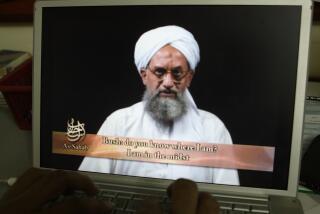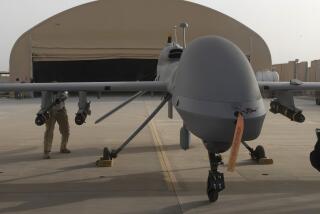Terror Plotter May Be Trapped
WASHINGTON — Hundreds of Pakistani troops, operating in the rugged terrain on the border with Afghanistan, traded heavy fire Thursday with foreign fighters who U.S. officials said might be defending Al Qaeda leader Osama bin Laden’s longtime second-in-command, Ayman Zawahiri.
If Zawahiri were captured or killed, the U.S. officials said, it would mark perhaps the most significant victory yet in the U.S.-led effort to crush the Al Qaeda terrorist network.
Officials in Peshawar said Pakistani forces resumed their assault against an estimated 200 heavily armed foreign fighters today in the mountains and well-protected villages of the South Waziristan tribal region, long believed to be the hide-out of Al Qaeda’s top two leaders.
Casualties have been reported on both sides in the fighting, which began Tuesday and is part of an offensive against Al Qaeda launched jointly by the Pakistani government and U.S. forces just across the border in Afghanistan. Pakistani officials also said some fighters had been taken into custody.
Residents of the town of Wana, reached by telephone, said heavy weapons were being used in the operation and the military had cordoned off a large area in the village of Azam Warsak.
The Bush administration declined to comment publicly late Thursday on whether Zawahiri was the target of the operation.
“We don’t know anything new,” President Bush told reporters.
But several U.S. officials acknowledged privately that Pakistan had shared intelligence with Washington suggesting that Zawahiri could be the “high value” target the foreign fighters were defending. In interviews, the U.S. officials, who declined to be identified, said the Pakistanis’ belief was based on more than the fact that their troops had encountered unusually fierce resistance. The officials said they could not provide details.
“That’s the assumption of pretty much everybody here in the intelligence community,” one official said. “But it’s too early and too speculative to say anything for certain.”
That official and others cautioned that initial reports about military confrontations on foreign soil were often speculative. Pakistani President Pervez Musharraf has refused to allow U.S. troops into the Pakistani border area, and U.S. intelligence and military officials said Thursday that no American troops, CIA operatives or other U.S. personnel were involved in the fighting. But they said surveillance aircraft patrolling the region were among a host of U.S. intelligence assets monitoring Al Qaeda and Taliban movements and supporting Pakistani operations on the ground.
The aircraft involved include so-called JSTARS planes designed to track targets from high altitudes in all weather conditions and unmanned Predator drones armed with Hellfire antitank missiles. U.S. satellites and electronic monitoring and eavesdropping equipment are also trained on Taliban and Al Qaeda redoubts.
U.S. and Pakistani officials downplayed widespread media speculation that Zawahiri had been positively identified as the quarry and that he had been cornered by Pakistani forces in such a way that capture or even containment was imminent.
The mountain passes of South Waziristan and neighboring areas are often impenetrable and are riddled with secret Al Qaeda tunnels and escape routes that could allow the foreign fighters to vanish during the night, even with forces on the ground and planes overhead, U.S. and Pakistani officials said.
In recent weeks, thousands of U.S. and Pakistani troops, operating on both sides of the border, have intensified their efforts to capture Al Qaeda’s top leaders.
“Capturing Osama bin Laden would have enormous symbolic value. But capturing Zawahiri ... would have enormous operational value,” said Rep. Jane Harman (D-Venice), a member of the House Intelligence Committee, which receives classified briefings on Al Qaeda’s status.
“I’m not going to reveal anything classified, but [Zawahiri] is capable of spearheading terrorist operations for Al Qaeda, the kind which we are seeing on a weekly basis,” she said. “He is the closest confidant of Bin Laden. He has a particular role as the top aide to Bin Laden, which is also significant. And [if captured alive], he might be very helpful to us in finding Bin Laden.”
Zawahiri, 52, is credited perhaps even more than Bin Laden with directing Al Qaeda’s anger toward the United States, as opposed to the Saudi Arabian government that expelled Bin Laden. An Egyptian physician and Islamic scholar, he headed the Egyptian Islamic Jihad before merging that terrorist group with Bin Laden’s Al Qaeda in the late 1990s.
Since the merger, Zawahiri has attended to Bin Laden’s medical needs and the two have been virtually inseparable, U.S. officials believe. Zawahiri was indicted in the United States for the 1998 bombings of American embassies in Kenya and Tanzania that killed at least 224 people, and U.S. officials suspect him of playing a central role in most other major Al Qaeda attacks.
U.S. officials said there was no solid intelligence on whether Zawahiri and Bin Laden had been in contact recently or had traveled together, as they routinely did before the Sept. 11 attacks against the United States.
On Thursday, Washington doubled the bounty on Bin Laden, saying it would pay up to $50 million for his capture.
In recent testimony on Capitol Hill, CIA Director George J. Tenet said Bin Laden had gone “deep underground.”
U.S. counter-terrorism officials and experts said the capture or killing of Zawahiri would be a crippling but not fatal blow to Al Qaeda.
Tenet, in his testimony, warned that Al Qaeda had splintered and inspired a wave of new groups that would pose a threat even if top figures were captured or killed.
*
Special correspondent Zulfiqar Ali in Peshawar contributed to this report.
More to Read
Sign up for Essential California
The most important California stories and recommendations in your inbox every morning.
You may occasionally receive promotional content from the Los Angeles Times.










